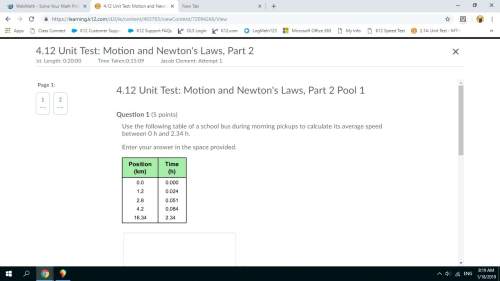
Physics, 09.04.2020 18:10 patriciahonsakpa6u5f
FNTs 5 and 6 emphasized the significance of the beginning and end of the interval. This FNT asks you to determine the interval (specifically the final state) using Energy-Interaction Model, given the amount of heat transferred to the system. 7) Now, imagine you are gradually adding heat to a 500g block of ice initially at -25°C. You can ignore the pot's thermal energy and assume all input energy is perfectly transferred to the H2O. One question that could be asked is, What is the final state of the water (phase and temperature) after the addition of 252 kJ of heat?" a) Explain why, based only on the given information and without further analysis/calculation, it is not possible to construct a single energy-system diagram that could be used to determine the final state of the water. (Hint: try to construct such a diagram. Explain why you can't.) In cases like this, you must first use the model to analyze a shorter interval. Can you construct an energy system diagram that could be used to determine how much energy is needed to increase the temperature of the ice from -25°C to 0°C? How does this energy compare to 252 kJ? Now explain how to proceed using the Energy-Interaction Model to find the final state of the H2O, when 252 kJ are added.

Answers: 3
Another question on Physics

Physics, 21.06.2019 22:30
Follow these directions and answer the questions. 1. shine a pencil-thin beam of light on a mirror perpendicular to its surface. (if you don't have a laser light as suggested in the video, you can make a narrow beam from a flashlight by making a cone from black construction paper and taping it over the face of the flashlight.) how does the light reflect? how does the relationship of incident to reflected ray relate to the reflection of water waves moving perpendicular to a barrier? 2. shine a pencil-thin beam of light on a mirror standing on a sheet of paper on the table (or floor) so that you can mark the incident ray and reflected ray. (you can support the mirror from the back by taping it to a wooden block.) 3. mark a line on the paper representing the reflective surface. (the reflective surface of a mirror is usually the back edge.) 4. draw a dashed line perpendicular to the mirror surface at a point where the incident and reflected ray meet. this perpendicular is called a normal to the surface. 5. measure the angles between the rays and the normal. the angle of incidence is the angle formed by the incident ray and the normal to the surface. the angle formed by the reflected ray and normal is called the angle of reflection (r). what is the angle of incidence? what is the angle of reflection? 6. repeat for several different angles. (see report sheet for details.) what appears to be the relationship between the angle of incidence and angle of reflection? in science 1204, what was the relationship for these two angles made by the reflection of waves in a ripple tank? 7. roll a ball bearing so that it hits a fixed, hard surface (a metal plate) at several angles (including head-on). observe the way in which the ball bearing reflects. what generalization can you make about how a ball bearing reflects from a wall? have you proved that light can only behave like a wave?
Answers: 1

Physics, 22.06.2019 12:10
The average density of the planet uranus is 1.27 103 kg/m3. the ratio of the mass of neptune to that of uranus is 1.19. the ratio of the radius of neptune to that of uranus is 0.969. find the average density of neptune.
Answers: 1

Physics, 22.06.2019 16:30
When conducting an investigation to determine which type of fertilizer produces the most flowers on a plant, which variable would be graphed on the x-axis once you collected the data? a. type of fertilizer b. amount of flowers c. amount of water d. number of days that the plants grew
Answers: 1

Physics, 23.06.2019 06:50
The results of huy's eye exam show that he is nearsighted. which explanation should huy expect to hear? "you need convex lenses to shorten the distance that light takes to focus in your eyes." "you need concave lenses to shorten the distance that light takes to focus in your eyes." "you need convex lenses to lengthen the distance that light takes to focus in your eyes." "you need concave lenses to lengthen the distance that light takes to focus in your eyes."
Answers: 1
You know the right answer?
FNTs 5 and 6 emphasized the significance of the beginning and end of the interval. This FNT asks you...
Questions

English, 14.09.2020 02:01

Mathematics, 14.09.2020 02:01

Mathematics, 14.09.2020 02:01

Mathematics, 14.09.2020 02:01

History, 14.09.2020 02:01

Mathematics, 14.09.2020 02:01

History, 14.09.2020 02:01

Mathematics, 14.09.2020 02:01

Mathematics, 14.09.2020 02:01

Mathematics, 14.09.2020 02:01

Mathematics, 14.09.2020 02:01

Mathematics, 14.09.2020 02:01

Mathematics, 14.09.2020 02:01

Mathematics, 14.09.2020 02:01

Biology, 14.09.2020 02:01

Mathematics, 14.09.2020 02:01

Mathematics, 14.09.2020 02:01

English, 14.09.2020 02:01

Mathematics, 14.09.2020 02:01

English, 14.09.2020 02:01




